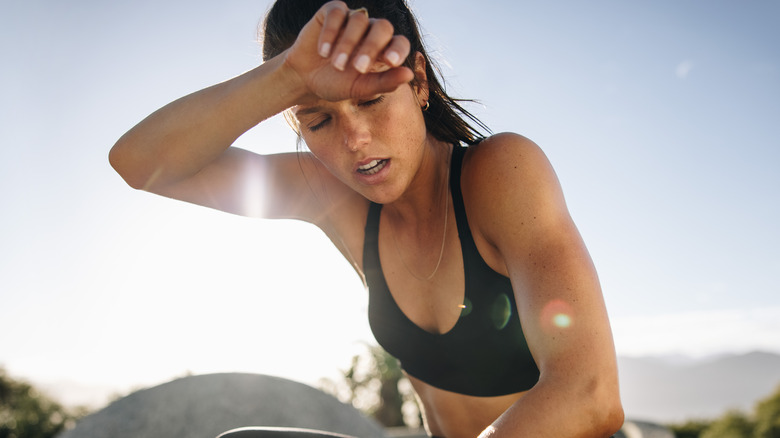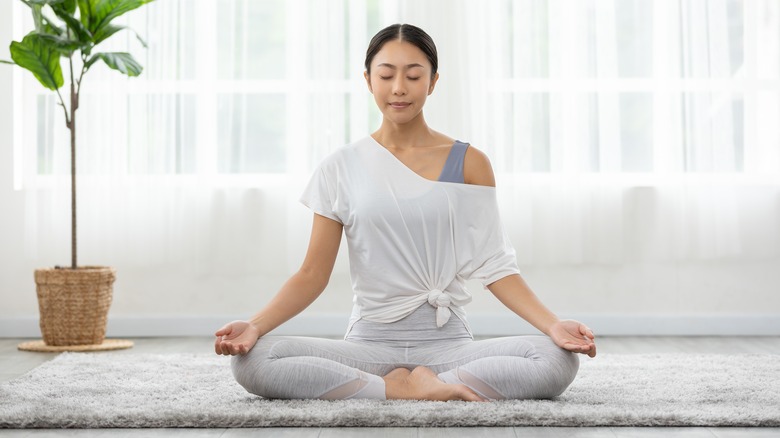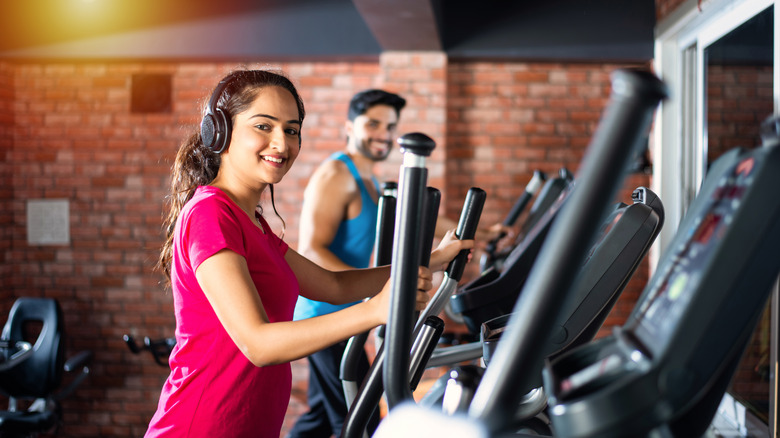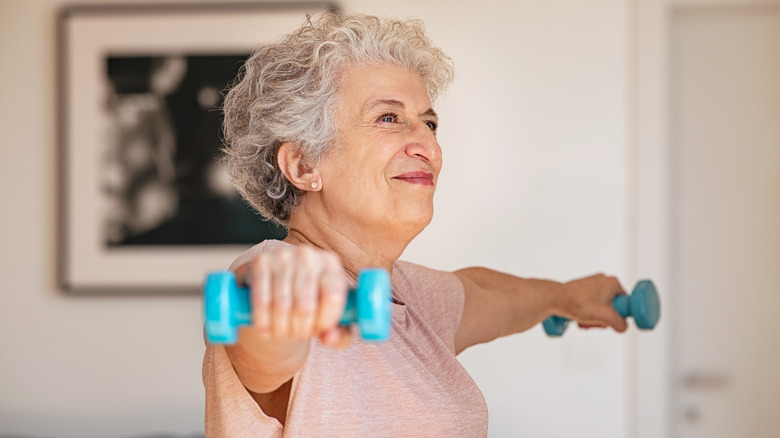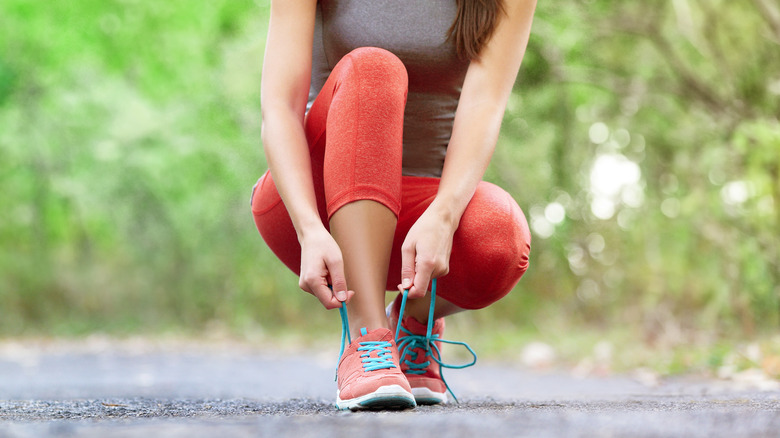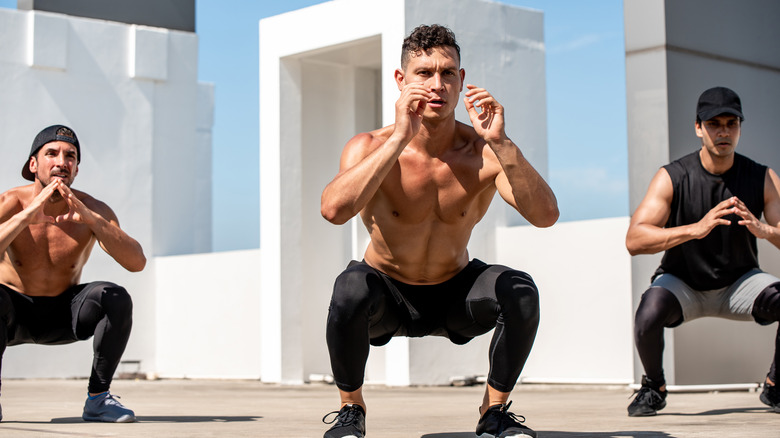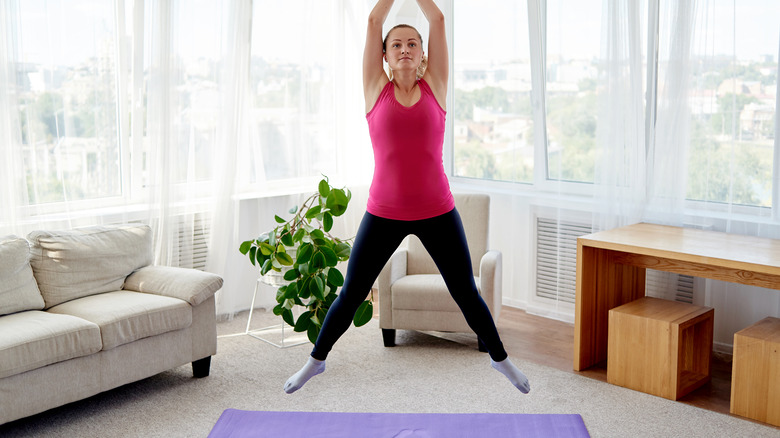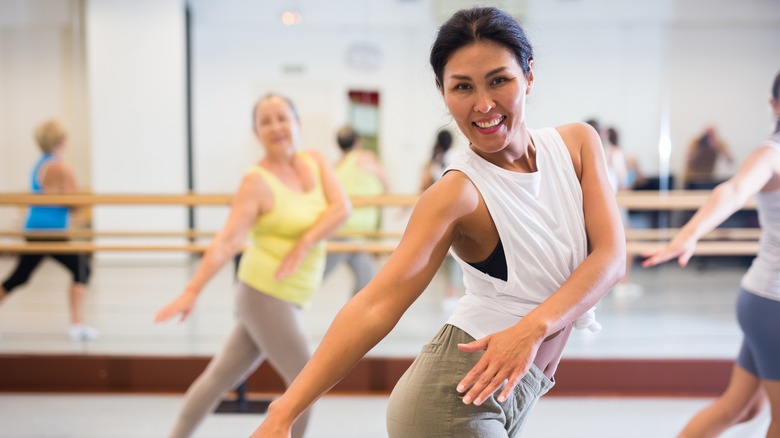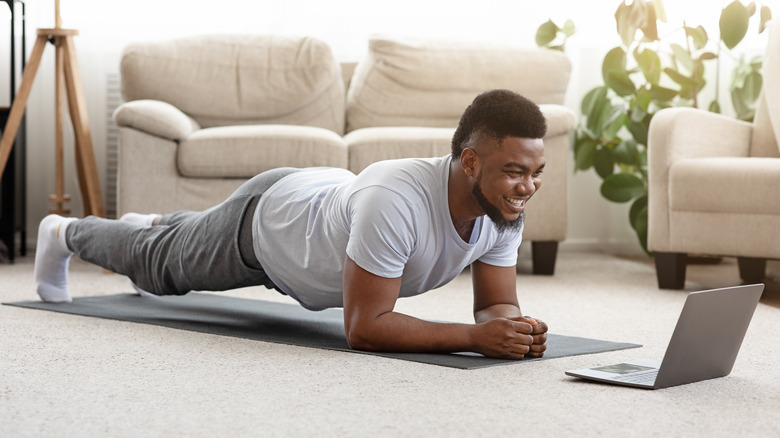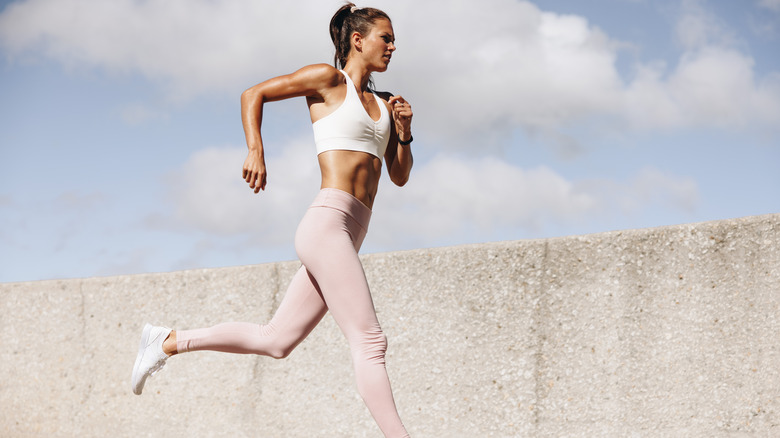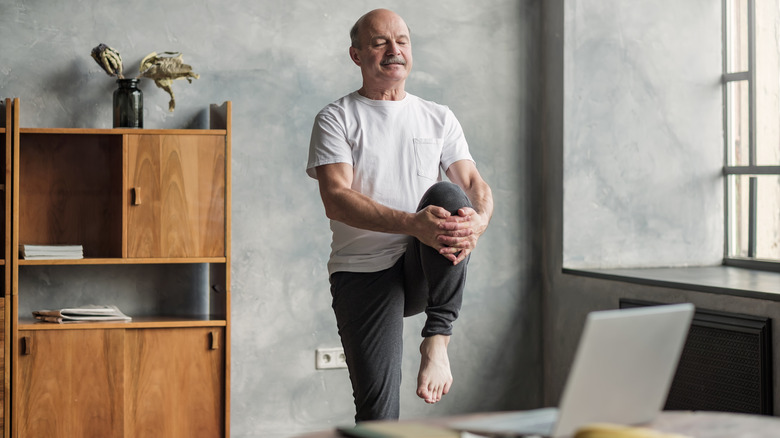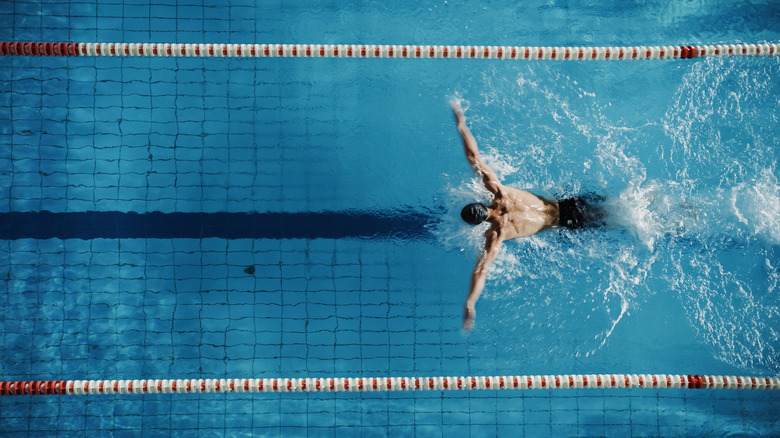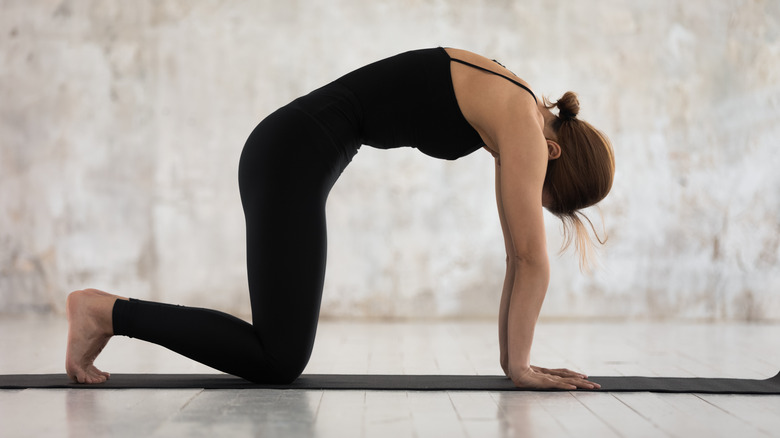The Best Exercises For When You Feel Tired
We've all been there. You've had a long day, or a long week, or a long year (or a long life). You're feeling, quite frankly, done. But then your scheduled time to head to the gym or out for a run rolls around, and aside from dreading it with every passing second, you're presented with a choice. Do you decide to skip "just for today" because you don't want to make yourself feel even more tired? Or do you take a deep breath and give it a go?
If you've chosen the latter, it turns out you're in good company. All of us know how daunting working out while tired can be, but the truth is that it can be pretty darn helpful. "It is sometimes good to work out even when you are tired, because, depending on how tired you are, exercise can give you the needed energy boost to help get you through your day or evening," advises certified personal trainer and health coach Shawna Norton (via Aaptiv). But the key to making sure your workout is effective when you're not feeling 100% is choosing your exercise wisely.
Not all workouts are created equal, and as Norton says, assessing what your body needs before an exercise session will help you make the right choice. And if you're struggling for inspiration, we've got the breakdown of the best exercises out there.
First things first: sometimes, you should just rest
While there are times when tiredness can be relieved by some exercise, there are also times when exercising is not the right choice.
Learning to discern when pure rest is needed is imperative to helping your body remain in good health and ready for future activity. Although there are few hard and fast rules, Muscle + Flow creator and Johns Hopkins adjunct associate Shauna Harrison recommends checking in with yourself by questioning how much sleep you've had, how fatigued your body's feeling from previous exercise, and whether you have any pain or injuries from any recent physical activity (per SELF). If you think that your tiredness is related to overtraining or you're worried that you don't have enough gas in the tank to exercise, it's usually a sign that you need a rest.
Mental fatigue or tiredness can also be a good reason for you to take a break instead of pushing through with exercise, as well as assessing whether your body has recently fought (or is fighting) an illness, Harrison states. Above everything, it's important to be really honest with yourself about what your intentions are. If you're exercising because you instinctively know it'll pick you up, go for it! But if you're forcing yourself into it at the expense of something else, resting up might be the better option.
Yoga can help to wake up mind and body
While not all forms of yoga are low-key (we're looking at you, power yoga), a gentle yoga practice can help keep you active when you're not exactly feeling the most lively you've ever felt.
Practices like hatha yoga place emphasis on restoration and mindfulness practice, and its focus on static poses can be a good choice to gently wake up your mind and body (per Verywell Fit). Just bear in mind that choosing one of these classes can result in a practice that requires less physical exertion, and therefore may be too mild for some. "Classes that focus more on mindfulness and restoration may not get your heart rate up that much," states Mayo Clinic Sports Medicine co-director Edward Laskowski (via Everyday Health).
Yoga is also an excellent activity to do first thing in the morning. "Yoga's a great thing to do when you first wake up, just to move the body and get the blood flowing. If you can go through just a few simple yoga poses in the morning, your body is going to be awake but your mind is also going to feel more awake and you'll feel refreshed," says yoga instructor Sarah Tiefenthaler to Reebok. An early-morning practice composed of simple moves like the back-bend, downward dog, seated side stretch, lizard stretch, and twisted lunges can all help you get ready to face the day.
The elliptical gives you a calm, fun workout
The elliptical trainer is kind of a love-it-or-hate-it machine at the gym: Some swear by it, while others avoid it like the plague. But if you're feeling a little tired, we'd recommend trying to move past your prejudice toward the elliptical and give it a go.
The machine is a favorite of Equinox Fitness certified personal trainer Anna Zucker when she's not feeling super energized. "I will still feel good afterward, but it doesn't require as much mental and physical energy as [weight lifting]. You don't need to think too much about form or recruiting every muscle in your body: just move and sweat and it's over," Zucker says to Bustle.
Another benefit of using an elliptical when you're tired is that it's a low-impact form of exercise, meaning that you'll won't have to think much about balance and control while still gaining a good cardio workout, according to Shape. And the best thing is, working out on an elliptical basically permits you to listen to your favorite podcast or audiobook while you work out, especially when you're tired. Hey, if you've put the work in to get to the gym when you're not feeling your best, you deserve to treat yourself.
Light weight training gives you a good burn
Some believe that if you're working out with weights, you have to go hard. But this isn't necessarily the case, and in circumstances where you're tired, a strength workout with lighter weights lets you continue to work your muscles while not over-exerting yourself.
What's more, using light weights can help you trick yourself into a surprisingly good workout. "With light weights and higher reps (think: 15 to 20, or more), you'll still feel the same kind of burn as lifting a heavier weight around five times," says Peloton senior instructor Emma Lovewell (via InStyle). And we can pretty much guarantee that light weight training will feel way less daunting than picking up that enormous barbell.
You can keep it small and use light weights for simpler exercises like bicep curls, or try using them with full-body movements to increase the efficiency and effectiveness of your workout. Squat thrusts are an excellent choice for this. Start with your feet shoulder-width apart and your weights held on each shoulder. Inhale and come down into a squat position. On your exhale, push back up to standing with your legs, and drive your weights above your head towards the sky in a shoulder press movement.
Walking helps to activate the nervous system
Walking can get a muted reception as an exercise, but honestly, it's one of the simplest and most effective ways to get your blood moving. And when you're a little exhausted, a walk is pretty much the best thing you can do to clear the cobwebs, so to speak.
Walking is particularly effective in the morning for waking us up, with a brisk walk helping to activate the nervous system and increase circulation around our bodies, says Verywell Fit. A walk on your lunch break can also reinvigorate you after sitting for hours at your desk, enabling you to get over the afternoon slump.
Bear in mind, however, that even though walking can be a gentle form of exercise, the body still needs a little time to warm up if you do it first thing in the morning. If your morning walk is intended to be particularly vigorous to shake you out of your tiredness, it may well be worth doing some gentle stretching before you begin.
HIIT workouts give you a time-efficient workout -- but don't overdo it
Now we know that seeing the words "HIIT workouts" isn't going to fill the weary out there with joy. When you're tired, it might seem like there's nothing worse. But honestly, there's a lot to be said for the power of a quick blast of high-intensity exercise to wake us up, and HIIT workouts are quick.
"HIIT workouts can be as short as four minutes (like Tabata) or last 30 minutes, and even if you're super tired, you can spare a few," says NASM-certified personal trainer Sarah Chadwell to PopSugar. "There are so many different types of HIIT routines that at least one will definitely fit your fitness level and needs. You'll be done quickly and feel refreshed."
Remember, though, that if your tiredness is due to a lack of sleep or exercising too much, doing a HIIT workout may make it worse. As a high-intensity exercise, HIIT training releases cortisol (a substance also known as the stress hormone) into your bloodstream, which causes you to become more alert (per the Journal of Endocrinological Investigation). Moreover, according to research published in the Natural Medicine Journal, too much cortisol in the bloodstream can disrupt sleep and restfulness. Thus, while HIIT workouts may energize you, using them to make up for a lack of sleep caused by a HIIT workout is a recipe for disaster.
With bodyweight plyometrics, you can work out easily when you're tired
With the boom in home workouts, the popularity of plyometrics has exploded. And when you're a little bit tired, a plyometric workout using mainly your body weight can get a spring back into your step in no time. "Bodyweight plyometric workouts are designed to get your heart rate up and stimulate your central nervous system. They will have you awake and feeling refreshed by the end," states certified personal trainer and health coach Shawna Norton (via Aaptiv). And as a bonus, plyometric workouts are designed to be accessible and to be done pretty much anywhere. There's no need to trek down to the gym to do them; just find a space in your home and away you go.
For a super-quick, energizing bodyweight plyometrics workout, try beginning with a round of squats (15-20 reps), and then five reps of squat jumps with rest between sets, advises Daily Burn. Step jacks followed by star jumps are also a great plyometrics combo, says Daily Burn 365 trainer CeCe Marizu. During your star jumps, make sure to bend your knees ever so slightly to help you get maximum height. "Think of your knees like a coil," Marizu says. "When you press down into them in a tighter position, the spring moves a little faster and with more force,"
Dancing wakes up, and makes you feel good
How many times have you had plans with friends to go out dancing, but when it gets to it, you just can't? If you're anything like us, you know the allure of staying in and resting, even though you know you'll probably enjoy it. But dancing when you're tired isn't just a great way to let your hair down and have fun, it's also an exercise that can seriously energize you.
A study published in Perceptual and Motor Skills examined the effects of aerobics and hip-hop dancing on the energy levels of high school and university students. Researchers found that these students were less tired after dancing, as well as feeling in a better mood.
Aside from helping you wake up, dancing as exercise also helps to improve your coordination, increase muscle tone and strength, and foster greater self-expression and self-confidence, states Ballet Fusion founder Rhea Sheedy (per Women's Health). Thanks to the wonders of YouTube, there's every kind of dance session you could want at your fingertips, so you don't have to face the grueling prospect of getting to a class. To get you in the zone and wake you up first thing in the morning, try a three-minute dance blast to none other than Little Mix, choreographed and led by Fit Body by Ashley. We can think of worse ways to start our day.
Pilates is great first thing in the morning
Famed for its gentle yet focused approach to building body strength and endurance, Pilates tends to be a go-to exercise system, whatever your energy levels are. When you're tired, it particularly comes into its own. It's especially effective as an exercise to do first thing in the morning when you're a little groggy, as the full-body nature of Pilates exercises can help warm you up from head to toe and increase circulation (per Complete Pilates).
For a few go-to Pilates exercises to prepare you for a busy day, try a simple circuit as recommended by SoBe Pilates co-owner and Pilates Method Alliance-certified instructor Susie Karvelis (via Glamour). Begin with a ball roll, slowly rocking your spine back against the floor while in a ball position to help wake up your back and abdominals. Move to a single-leg stretch, pulling alternating legs to your chest while lying on your back, then single-leg circles, raising one leg to the sky (again, while on your back) and slowly rotating it, the other leg flat on the floor. Finish up with a torso twist, gently dropping your bent knees from one side to the other while on your back, and end with a half-roll back, rolling your back against the floor halfway down your spine, and then coming up to a seated position.
Running outside can revitalize you
Whether it's thanks to poor sleep or a punishing training schedule for a race, surmounting the tiredness barrier to get your running miles in is no joke. But a mere 20 minutes of running can significantly improve our alertness and brain processing speed, as well as help blood flow and circulation throughout the body, as found in research conducted with Asics (and discussed via Coach Magazine).
And there's also the nature of, well, nature to consider. Research published in the Journal of Environmental Psychology has shown the link between being outside in nature and increased vitality, another reason to get outside for that morning jog. "Often when we feel depleted we reach for a cup of coffee, but research suggests a better way to get energized is to connect with nature," says lead study author and University of Rochester professor of psychology Richard Ryan (via the University of Rochester).
But if you're struggling with the thought of going on yet another run on the same route, there are some easy changes you can make to your workout to invigorate you further. "One of the simplest changes to make is to run a route in the reverse direction," recommends NASM-certified personal trainer Marty Beene to HuffPost. "Seeing the same scenery from a different angle is remarkably refreshing, and can definitely be a step toward getting rid of mental fatigue."
Stretching provides gentle blood flow
There are few things as pleasing as a really good stretch. And as it turns out, there are few things more energizing, too, when you're feeling it.
The gentle nature of stretching, especially first thing in the morning, gently stimulates the body and mind and allows them to wake up, says L.A.-based injury rehab specialist and personal trainer Liz Letchford (via HuffPost). By waking up our muscles through stretching, we also increase blood flow throughout our bodies, improve the range of motion in our muscles and joints, and prepare our bodies for the rest of the way (per the Mayo Clinic).
For simple stretching in the morning, there are few better places to start than with an above-the-head stretch, says Fix It Physical Therapy owner Kelly Roberts Lane (per HuffPost). "Reach your arms all the way over your head and look up. Then, roll your spine down one vertebra at a time until you are touching your toes or are as close to them as you can get. Let your head hang. Straighten one knee and then the other to get a deeper hamstring stretch," says Roberts Lane. Just bear in mind that if you're stretching out muscles that are injured or strained, you risk damaging them further (via the Mayo Clinic).
Swimming helps improve blood flow to the brain
Okay, sure, swimming can take a little more preparation than other exercises. But don't let that thought put you off when you're feeling drained.
Swimming is one of the best exercises you can do when you're not full of energy, and may make you feel more refreshed and alert after doing so, says the Physiotherapy and Rehabilitation Centres of Ontario. Swimming can improve circulation in the body and to the muscles, and can strengthen cardiovascular capacities and flexibility. Additionally, full-body contact with water may improve blood flow to the brain and our cognitive function, as research published in Physiological Reports shows. Not only could this help increase alertness and wake us up, but it may even reduce the risk of age-related cognitive decline.
If you thought that swimming's benefits ended with just waking you up a little, you'll be surprised. Swimming regularly can (deep breath) help increase your lung capacity and support healthy breathing, manage blood sugar levels, improve sleep, tone your muscles, improve your mood and lower anxiety, and reduce your risk of cardiovascular illness (per Medical News Today). Honestly, get us to a pool right now.
Mobility workouts help to limber up your body
Do you know that stiff, slightly clunky feeling you can have when you're feeling tired? That can be enough to stop you from wanting to do exercise in itself. But doing a workout meant to tackle that very feeling can not only help you become more limber, but may also leave you feelinh a little more alert afterward.
"I'd recommend doing simple mobility exercises to warm up your body," says .1 Method founder and trainer Anthony Crouchelli to HuffPost. "Easy movements, like hip-openers, glute bridges or lateral lunges can help you improve your flexibility and function," and keep you moving on days where more hardcore workouts may not be on the cards for your energy levels.
Practicing controlled articular rotations (CARs) can also enable your joints to keep moving and increase your range of motion, says Crouchelli. These movements are useful to do alongside static stretches, and use rotating or rolling motions to help free up movement and assist in post-injury rehabilitation (via Invictus Fitness). Try some simple neck rolls, wrist rotations, arm circles, and a cat-cow sequence alongside other mobility workout movements.

